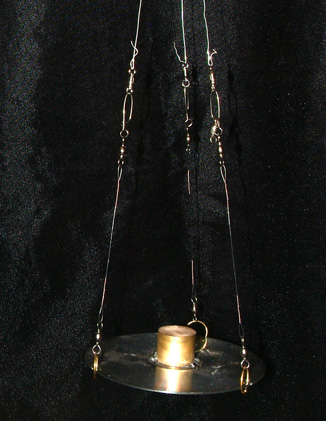![[Finger action]](twist1.jpg)
|
The twisted center strand that I use in many of my rings is actually made in a similar fashion to rope. The three strands are held at one end, and led through a wooden thimble with three holes cut through it, so the strands can un-twist as they are moved into place. Rope, as you may know, is given an extra twist to help it lay up in the group and to keep them together, but for gold wire it is sufficient to merely allow it to lay up with a minimum amount of internal tension.
|
|
Dangling below where I am moving the thimble, it is necessary to keep the wires separate while still allowing them full freedom to turn. The loose twisted wire dangling next to the ones I'm working on is actually the same piece, as I had moved it up to keep the work at a convenient level for me. If I have to make a really long twisted wire, for a bracelet, I could end up moving it several times.
|
![[Rope walk]](twist2.jpg)
|

|
As you can see, there is actually something that can be done with the flood of CDs pouring into your mail-slots from the online services. They make great driveway markers, also, nailed to fenceposts or trees. (Label side down, of course. They're far prettier that way, and you're not going to be paid to advertise for those folks anyway, even if you ask nicely.)
This is a more recent picture, and it shows fishing leaders and swivels instead of the vise-grip style pliers in the other pictures. The bottom end of the wire has to be secured, but still permitted to turn freely, so the swivels on the leaders make that possible. These swivels are the nice ball-bearing type, and they come in pairs -- you'll notice a second one dangling from one side, that's where I put the extra, so I can find it if I need it.
|
Not sure if you can tell colors well with this picture, but you can see that the three wires are flowing smoothly into the twist. I was using two strands of rose gold and one of yellow, if I remember correctly, when I took this sequence of pictures.
You can see that the twist is right handed, which is the "proper" direction for traditional rope. There are ropes that are "left-laid", for special purposes, and a tow-rope made with several individual "right-laid" ropes will end up going the other way, but I chose to do right handed line. Guess I'm just a stick-in-the-mud.
|
![[Closeup of wire]](twist4.jpg)
|
|
|